Engage NY Eureka Math 1st Grade Module 2 Lesson 17 Answer Key
Eureka Math Grade 1 Module 2 Lesson 17 Sprint Answer Key
A
*Write the missing number. Pay attention to the addition or subtraction sign.
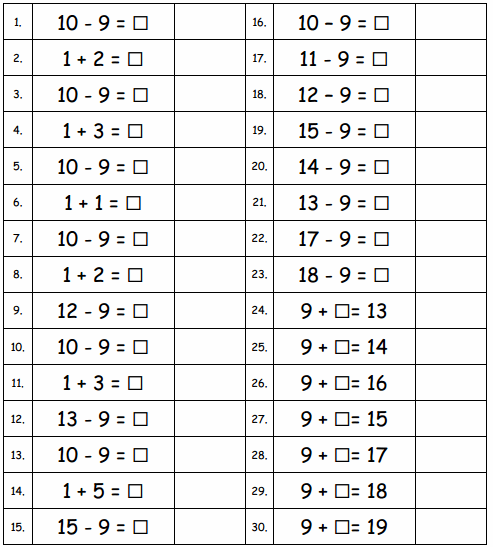
Answer:

Question 1.
10 – 9 = ☐
Answer:
10 – 9 = 1
Explanation:
Subtraction is an arithmetic operation that represents the operation of removing objects from a collection. The result of a subtraction is called a difference. Subtract nine from ten then we got one.
Question 2.
1 + 2 = ☐
Answer:
1+ 2 = 3
Explanation:
An addition sentence is a mathematical expression that shows two or more values added together. ADD one with two then we got three.
Question 3.
10 – 9 = ☐
Answer:
10 – 9 = 1
Explanation:
Subtraction is an arithmetic operation that represents the operation of removing objects from a collection. The result of a subtraction is called a difference. Subtract nine from ten then we got one.
Question 4.
1 + 3 = ☐
Answer:
1 + 3 = 4
Explanation:
An addition sentence is a mathematical expression that shows two or more values added together. ADD one with three then we got four.
Question 5.
10 – 9 = ☐
Answer:
10 – 9 = 1
Explanation:
Subtraction is an arithmetic operation that represents the operation of removing objects from a collection. The result of a subtraction is called a difference. Subtract nine from ten then we got one.
Question 6.
1 + 1 = ☐
Answer:
1 + 1 = 2
Explanation:
An addition sentence is a mathematical expression that shows two or more values added together. ADD one with one then we got two.
Question 7.
10 – 9 = ☐
Answer:
10 – 9 = 1
Explanation:
Subtraction is an arithmetic operation that represents the operation of removing objects from a collection. The result of a subtraction is called a difference. Subtract nine from ten then we got one.
Question 8.
1 + 2 = ☐
Answer:
1 + 2 = 3
Explanation:
An addition sentence is a mathematical expression that shows two or more values added together. ADD one with two then we got three.
Question 9.
12 – 9 = ☐
Answer:
12 – 9 = 3
Explanation:
Subtraction is an arithmetic operation that represents the operation of removing objects from a collection. The result of a subtraction is called a difference. Subtract nine from twelve then we got three.
Question 10.
10 – 9 = ☐
Answer:
10 – 9 = 1
Explanation:
Subtraction is an arithmetic operation that represents the operation of removing objects from a collection. The result of a subtraction is called a difference. Subtract nine from ten then we got one.
Question 11.
1 + 3 = ☐
Answer:
1 + 3 = 4
Explanation:
An addition sentence is a mathematical expression that shows two or more values added together. ADD one with three then we got four.
Question 12.
13 – 9 = ☐
Answer:
13 – 9 = 4
Explanation:
Subtraction is an arithmetic operation that represents the operation of removing objects from a collection. The result of a subtraction is called a difference. Subtract nine from thirteen then we got four.
Question 13.
10 – 9 = ☐
Answer:
10 – 9 = 1
Explanation:
Subtraction is an arithmetic operation that represents the operation of removing objects from a collection. The result of a subtraction is called a difference. Subtract nine from ten then we got one.
Question 14.
1 + 5 = ☐
Answer:
1 + 5 = 6
Explanation:
An addition sentence is a mathematical expression that shows two or more values added together. ADD one with five then we got six.
Question 15.
15 – 9 = ☐
Answer:
15 – 9 = 6
Explanation:
Subtraction is an arithmetic operation that represents the operation of removing objects from a collection. The result of a subtraction is called a difference. Subtract nine from fifteen then we got six.
Question 16.
10 – 9 = ☐
Answer:
10 – 9 = 1
Explanation:
Subtraction is an arithmetic operation that represents the operation of removing objects from a collection. The result of a subtraction is called a difference. Subtract nine from ten then we got one.
Question 17.
11 – 9 = ☐
Answer:
11 – 9 = 2
Explanation:
Subtraction is an arithmetic operation that represents the operation of removing objects from a collection. The result of a subtraction is called a difference. Subtract nine from eleven then we got two.
Question 18.
12 – 9 = ☐
Answer:
12 – 9 = 3
Explanation:
Subtraction is an arithmetic operation that represents the operation of removing objects from a collection. The result of a subtraction is called a difference. Subtract nine from twelve then we got three.
Question 19.
15 – 9 = ☐
Answer:
15 – 9 = 6
Explanation:
Subtraction is an arithmetic operation that represents the operation of removing objects from a collection. The result of a subtraction is called a difference. Subtract nine from fifteen then we got six.
Question 20.
14 – 9 = ☐
Answer:
14 – 9 = 5
Explanation:
Subtraction is an arithmetic operation that represents the operation of removing objects from a collection. The result of a subtraction is called a difference. Subtract nine from fourteen then we got five.
Question 21.
13 – 9 = ☐
Answer:
13 – 9 = 4
Explanation:
Subtraction is an arithmetic operation that represents the operation of removing objects from a collection. The result of a subtraction is called a difference. Subtract nine from thirteen then we got four.
Question 22.
17 – 9 = ☐
Answer:
17 – 9 = 8
Explanation:
Subtraction is an arithmetic operation that represents the operation of removing objects from a collection. The result of a subtraction is called a difference. Subtract nine from seventeen then we got eight.
Question 23.
18 – 9 = ☐
Answer:
18 – 9 = 9
Explanation:
Subtraction is an arithmetic operation that represents the operation of removing objects from a collection. The result of a subtraction is called a difference. Subtract nine from eighteen then we got nine.
Question 24.
9 + ☐= 13
Answer:
9 + 4 = 13
Explanation:
An addition sentence is a mathematical expression that shows two or more values added together. ADD nine with four then we got thirteen.
Question 25.
9 + ☐= 14
Answer:
9 + 5 = 14
Explanation:
An addition sentence is a mathematical expression that shows two or more values added together. ADD nine with five then we got fourteen.
Question 26.
9 + ☐= 16
Answer:
9 + 7 = 16
Explanation:
An addition sentence is a mathematical expression that shows two or more values added together. ADD nine with seven then we got sixteen.
Question 27.
9 + ☐= 15
Answer:
9 + 6 = 15
Explanation:
An addition sentence is a mathematical expression that shows two or more values added together. ADD nine with six then we got fifteen.
Question 28.
9 + ☐= 17
Answer:
9 + 8 = 17
Explanation:
An addition sentence is a mathematical expression that shows two or more values added together. ADD nine with eight then we got seventeen.
Question 29.
9 + ☐= 18
Answer:
9 + 9 = 18
Explanation:
An addition sentence is a mathematical expression that shows two or more values added together. ADD nine with nine then we got eighteen.
Question 30.
9 + ☐= 19
Answer:
9 + 10 = 19
Explanation:
An addition sentence is a mathematical expression that shows two or more values added together. ADD nine with ten then we got nineteen.
B
*Write the missing number. Pay attention to the addition or subtraction sign.
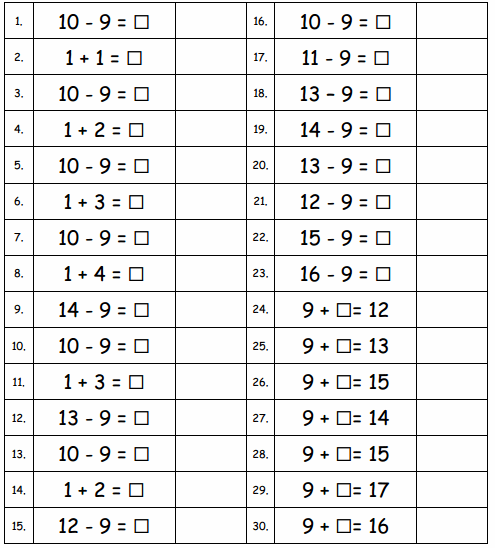
Answer:
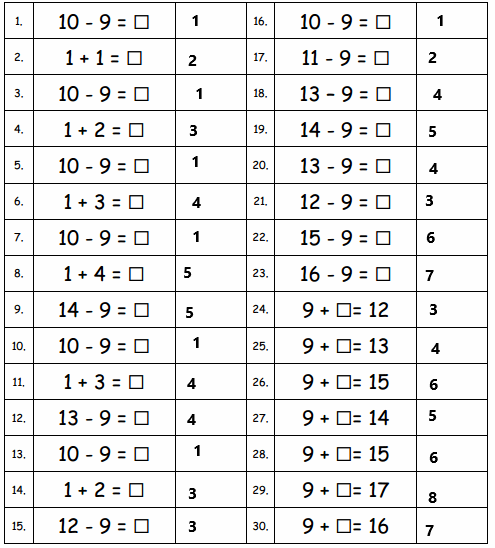
Question 1.
10 – 9 = ☐
Answer:
10 – 9 = 1
Explanation:
Subtraction is an arithmetic operation that represents the operation of removing objects from a collection. The result of a subtraction is called a difference. Subtract nine from ten then we got one.
Question 2.
1 + 1 = ☐
Answer:
1 + 1= 2
Explanation:
An addition sentence is a mathematical expression that shows two or more values added together. ADD one with one then we got two.
Question 3.
10 – 9 = ☐
Answer:
10 – 9 = 1
Explanation:
Subtraction is an arithmetic operation that represents the operation of removing objects from a collection. The result of a subtraction is called a difference. Subtract nine from ten then we got one.
Question 4.
1 + 2 = ☐
Answer:
1 + 2 = 3
Explanation:
An addition sentence is a mathematical expression that shows two or more values added together. ADD one with two then we got three.
Question 5.
10 – 9 = ☐
Answer:
10 – 9 = 1
Explanation:
Subtraction is an arithmetic operation that represents the operation of removing objects from a collection. The result of a subtraction is called a difference. Subtract nine from ten then we got one.
Question 6.
1 + 3 = ☐
Answer:
1 + 3 = 4
Explanation:
An addition sentence is a mathematical expression that shows two or more values added together. ADD one with three then we got four.
Question 7.
10 – 9 = ☐
Answer:
Subtraction is an arithmetic operation that represents the operation of removing objects from a collection. The result of a subtraction is called a difference. Subtract nine from ten then we got one.
Question 8.
1 + 4 = ☐
Answer:
1 + 4 = 5
Explanation:
An addition sentence is a mathematical expression that shows two or more values added together. ADD one with four then we got five.
Question 9.
14 – 9 =☐
Answer:
14 – 9 = 5
Explanation:
Subtraction is an arithmetic operation that represents the operation of removing objects from a collection. The result of a subtraction is called a difference. Subtract nine from fourteen then we got five.
Question 10.
10 – 9 = ☐
Answer:
10 – 9 = 1
Explanation:
Subtraction is an arithmetic operation that represents the operation of removing objects from a collection. The result of a subtraction is called a difference. Subtract nine from ten then we got one.
Question 11.
1 + 3 = ☐
Answer:
1 + 3 = 4
Explanation:
An addition sentence is a mathematical expression that shows two or more values added together. ADD one with three then we got four.
Question 12.
13 – 9 = ☐
Answer:
13 – 9 = 4
Explanation:
Subtraction is an arithmetic operation that represents the operation of removing objects from a collection. The result of a subtraction is called a difference. Subtract nine from thirteen then we got four.
Question 13.
10 – 9 = ☐
Answer:
10 – 9 = 1
Explanation:
Subtraction is an arithmetic operation that represents the operation of removing objects from a collection. The result of a subtraction is called a difference. Subtract nine from ten then we got one.
Question 14.
1 + 2 = ☐
Answer:
1 + 2 = 3
Explanation:
An addition sentence is a mathematical expression that shows two or more values added together. ADD one with two then we got three.
Question 15.
12 – 9 = ☐
Answer:
12 – 9 = 3
Explanation:
Subtraction is an arithmetic operation that represents the operation of removing objects from a collection. The result of a subtraction is called a difference. Subtract nine from twelve then we got three.
Question 16.
10 – 9 = ☐
Answer:
10 – 9 = 1
Explanation:
Subtraction is an arithmetic operation that represents the operation of removing objects from a collection. The result of a subtraction is called a difference. Subtract nine from ten then we got one.
Question 17.
11 – 9 = ☐
Answer:
11- 9 = 2
Explanation:
Subtraction is an arithmetic operation that represents the operation of removing objects from a collection. The result of a subtraction is called a difference. Subtract nine from eleven then we got two.
Question 18.
13 – 9 = ☐
Answer:
13 – 9 = 4
Explanation:
Subtraction is an arithmetic operation that represents the operation of removing objects from a collection. The result of a subtraction is called a difference. Subtract nine from thirteen then we got four.
Question 19.
14 – 9 = ☐
Answer:
14 – 9 = 5
Explanation:
Subtraction is an arithmetic operation that represents the operation of removing objects from a collection. The result of a subtraction is called a difference. Subtract nine from fourteen then we got five.
Question 20.
13 – 9 = ☐
Answer:
13 – 9 = 4
Explanation:
Subtraction is an arithmetic operation that represents the operation of removing objects from a collection. The result of a subtraction is called a difference. Subtract nine from thirteen then we got four.
Question 21.
12 – 9 = ☐
Answer:
12 – 9 = 3
Explanation:
Subtraction is an arithmetic operation that represents the operation of removing objects from a collection. The result of a subtraction is called a difference. Subtract nine from twelve then we got three.
Question 22.
15 – 9 = ☐
Answer:
15 – 9 = 6
Explanation:
Subtraction is an arithmetic operation that represents the operation of removing objects from a collection. The result of a subtraction is called a difference. Subtract nine from fifteen then we got six.
Question 23.
16 – 9 = ☐
Answer:
16 – 9 = 7
Explanation:
Subtraction is an arithmetic operation that represents the operation of removing objects from a collection. The result of a subtraction is called a difference. Subtract nine from sixteen then we got seven.
Question 24.
9 + ☐= 12
Answer:
9 + 3 = 12
Explanation:
An addition sentence is a mathematical expression that shows two or more values added together. ADD nine with three then we got twelve.
Question 25.
9 + ☐= 13
Answer:
9 + 4 = 13
Explanation:
An addition sentence is a mathematical expression that shows two or more values added together. ADD nine with four then we got thirteen.
Question 26.
9 + ☐= 15
Answer:
9 + 6 = 15
Explanation:
An addition sentence is a mathematical expression that shows two or more values added together. ADD nine with six then we got fifteen.
Question 27.
9 + ☐= 14
Answer:
9 + 5 = 14
Explanation:
An addition sentence is a mathematical expression that shows two or more values added together. ADD nine with five then we got fourteen.
Question 28.
9 + ☐= 15
Answer:
9 + 6 = 15
Explanation:
An addition sentence is a mathematical expression that shows two or more values added together. ADD nine with six then we got fifteen.
Question 29.
9 + ☐= 17
Answer:
9 + 8 = 17
Explanation:
An addition sentence is a mathematical expression that shows two or more values added together. ADD nine with eight then we got seventeen.
Question 30.
9 + ☐ = 16
Answer:
9 + 7 = 16
Explanation:
An addition sentence is a mathematical expression that shows two or more values added together. ADD nine with seven then we got sixteen.
Eureka Math Grade 1 Module 2 Lesson 17 Problem Set Answer Key
Question 1.
Match the pictures with the number sentences.

Answer:
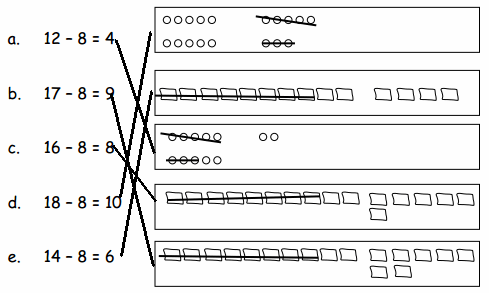
Explanation:
a. In the above image we can observe a number sentence 12 – 8= 4. Break twelve into ten and two. Take eight from the ten. It’s called the take from ten strategy. Cross out eight circles. Then two and two make four. The number sentence matches with the third picture in the right side.
b. In the above image we can observe a number sentence 17 – 8 = 9. Break seventeen into ten and seven. Take eight from the ten. It’s called the take from ten strategy. Cross out eight squares. Then two and seven make nine. The number sentence matches with the fifth picture in the right side.
c. In the above image we can observe a number sentence 16 – 8 = 8. Break sixteen into ten and six. Take eight from the ten. It’s called the take from ten strategy. Cross out eight squares. Then two and six make eight. The number sentence matches with the fourth picture in the right side.
d. In the above image we can observe a number sentence 18 – 8 = 10. Break eighteen into ten and eight. Take eight from the ten. It’s called the take from ten strategy. Cross out eight circles. Then two and eight make ten. The number sentence matches with the first picture in the right side.
e. In the above image we can observe a number sentence 14 – 8 = 6. Break fourteen into ten and four. Take eight from the ten. It’s called the take from ten strategy. Cross out eight squares. Then two and four make six. The number sentence matches with the second picture in the right side.
Circle 10 and subtract.
Question 2.
13 – 8 = ___
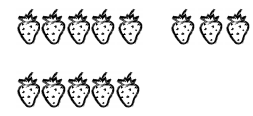
Answer:
13 – 8 = 5

Explanation:
In the above image we can observe a number sentence 13 – 8 = 5. Break thirteen into ten and three. First draw a circle for ten then take eight from the ten. It’s called the take from ten strategy. Cross out eight. Then two and three on other side make five.
Question 3.
11 – 8 = ___

Answer:
11- 8 = 3
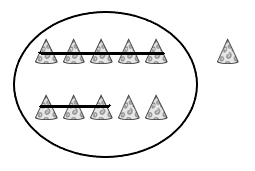
Explanation:
In the above image we can observe a number sentence 11 – 8 = 3. Break eleven into ten and one. First draw a circle for ten then take eight from the ten. It’s called the take from ten strategy. Cross out eight. Then two and one on other side make three.
Question 4.
15 – 8 = ___

Answer:
15 – 8 = 7

Explanation:
In the above image we can observe a number sentence 15 – 8 = 7. Break fifteen into ten and five. First draw a circle for ten then take eight from the ten. It’s called the take from ten strategy. Cross out eight. Then two and five on other side make seven.
Question 5.
19 – 8 = ___
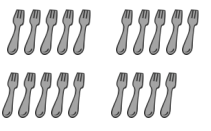
Answer:
19 – 8 = 11
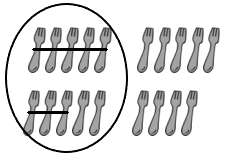
Explanation:
In the above image we can observe a number sentence 19 – 8 = 11. Break nineteen into ten and nine. First draw a circle for ten then take eight from the ten. It’s called the take from ten strategy. Cross out eight. Then two and nine on other side make eleven.
Question 6.
16 – 8 = __
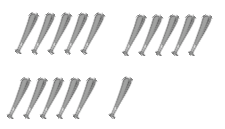
Answer:
16 – 8 = 8
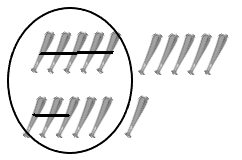
Explanation:
In the above image we can observe a number sentence 16 – 8 = 8. Break sixteen into ten and six. First draw a circle for ten then take eight from the ten. It’s called the take from ten strategy. Cross out eight. Then two and six on other side make eight.
Question 7.
17 – 8 = __
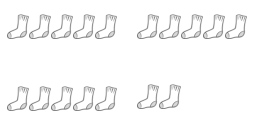
Answer:
17 – 8 = 9
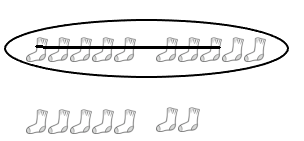
Explanation:
In the above image we can observe a number sentence 17 – 8 = 9. Break seventeen into ten and seven. First draw a circle for ten then take eight from the ten. It’s called the take from ten strategy. Cross out eight. Then two and seven on other side make nine.
Draw and circle 10, or break apart the teen number with a number bond. Then subtract.
Question 8.
12 – 8 = ___
Answer:

Explanation:
In the above image we can observe a number sentence 12 – 8 = 4. Break twelve into ten and two. First draw a circle for ten then take eight from the ten. It’s called the take from ten strategy. Cross out eight circles. Then two and two on other side make four.
Question 9.
13 – 8 = ___
Answer:
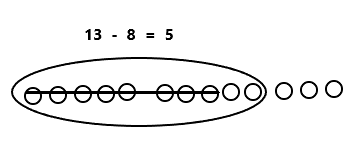
Explanation:
In the above image we can observe a number sentence 13 – 8 = 5. Break thirteen into ten and three. First draw a circle for ten then take eight from the ten. It’s called the take from ten strategy. Cross out eight circles. Then two and three on other side make five.
Question 10.
14 – 8 = ___
Answer:

10 – 8 = 2
2 + 4 = 6
Explanation:
In the above image we can observe a number sentence 14 – 8 = 6. A number bond is a simple addition of two numbers that add up to give the sum. Break fourteen into ten and four. Subtract eight from ten then we got two. ADD two with four then we got six.
Question 11.
15 – 8 = ___
Answer:

Explanation:
In the above image we can observe a number sentence 15 – 8 = 7. A number bond is a simple addition of two numbers that add up to give the sum. Break fifteen into ten and five. Subtract eight from ten then we got two. ADD two with five then we got seven.
Eureka Math Grade 1 Module 2 Lesson 17 Exit Ticket Answer Key
Question 1.
Draw and ![]() 10. Then subtract.
10. Then subtract.
a. 12 – 8 = _____
Answer:
12 – 8 = 4

Explanation:
In the above image we can observe a number sentence 12 – 8 = 4. Break twelve into ten and two. First draw a circle for ten then take eight from the ten. It’s called the take from ten strategy. Cross out eight circles. Then two and two on other side make four.
b. 14 – 8 = _____
Answer:
14 – 8 = 6

Explanation:
In the above image we can observe a number sentence 14 – 8 = 6. Break fourteen into ten and four. First draw a circle for ten then take eight from the ten. It’s called the take from ten strategy. Cross out eight circles. Then two and four on other side make six.
Question 2.
Use a number bond to break apart the teen number. Then subtract.
15 – 8 = _____
Answer:
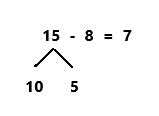
Explanation:
In the above image we can observe a number sentence 15 – 8 = 7. A number bond is a simple addition of two numbers that add up to give the sum. Break fifteen into ten and five. Subtract eight from ten then we got two. ADD two with five then we got seven.
Eureka Math Grade 1 Module 2 Lesson 17 Homework Answer Key
Question 1.
Match the number sentence to the picture or to the number bond.

Answer:
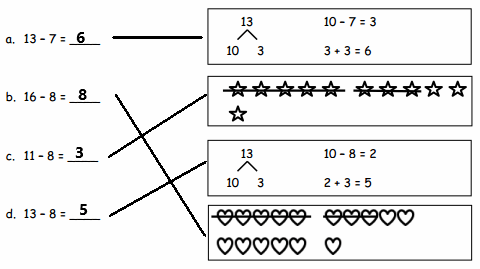
Explanation:
a. A number bond is a simple addition of two numbers that add up to give the sum. In the above image we can observe a number sentence 13 – 7 = 6. Break thirteen into ten and three. Subtract seven from the ten then we got three. ADD three with three then we got six. The number sentence matches with the first picture in the right side.
b. In the above image we can observe a number sentence 16 – 8 = 8. Break sixteen into ten and six. Take eight from the ten. It’s called the take from ten strategy. Cross out eight. Then two and six on other side make eight. The number sentence matches with the fourth picture in the right side.
c. In the above image we can observe a number sentence 11 – 8 = 3. Break eleven into ten and one. Take eight from the ten. It’s called the take from ten strategy. Cross out eight. Then two and one on other side make three. The number sentence matches with the second picture in the right side.
d. A number bond is a simple addition of two numbers that add up to give the sum. In the above image we can observe a number sentence 13 – 8 = 5. Break thirteen into ten and three. Subtract eight from the ten then we got two. ADD two with three then we got five. The number sentence matches with the third picture in the right side.
Question 2.
Show how you would solve 14 – 8, either with a number bond or a drawing.
Answer:
14 – 8 = 6

Explanation:
In the above image we can observe a number sentence 14 – 8 = 6. Break fourteen into ten and four. First draw a circle for ten then take eight from the ten. It’s called the take from ten strategy. Cross out eight circles. Then two and four on other side make six.
![]() 10. Then subtract.
10. Then subtract.
Question 3.
Milo has 17 rocks. He throws 8 of them into a pond. How many does he have left?

Answer:
17 – 8 = 9
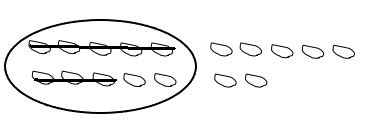
Milo have 9 rocks.
Explanation:
Milo has 17 rocks. He throws 8 of them into a pond. In the above image we can observe a number sentence 17 – 8 = 9. Break seventeen into ten rocks and seven rocks. First draw a circle for ten rocks then take eight rocks from the ten rocks. It’s called the take from ten strategy. Cross out eight rocks. Then two rocks and seven rocks on other side make nine rocks. Milo have 9 rocks left.
Draw and ![]() 10. Then subtract.
10. Then subtract.
Question 4.
Lucy has $12. She spends $8. How much money does she have now?
Lucy has $ __ now.
Answer:
12 – 8 = 4

Lucy has $ 4 now.
Explanation:
Lucy has $12. She spends $8. In the above image we can observe a number sentence 12 – 8 = 4. Break twelve into ten and two. First draw a circle for ten then take eight from the ten. It’s called the take from ten strategy. Cross out eight circles. Then two and two on other side make four. Lucy has $ 4 now.
Draw and ![]() 10, or use a number bond to break apart the teen number and subtract.
10, or use a number bond to break apart the teen number and subtract.
Question 5.
Sean has 15 dinosaurs. He gives 8 to his sister. How many dinosaurs does he keep?
Sean keeps __ dinosaurs.
Answer:
15 – 8 = 7

Sean keeps 7 dinosaurs.
Explanation:
Sean has 15 dinosaurs. He gives 8 to his sister. In the above image we can observe a number sentence 15 – 8 = 7. Break fifteen into ten dinosaurs and five dinosaurs. First draw a circle for ten dinosaurs then take eight dinosaurs from the ten dinosaurs. It’s called the take from ten strategy. Cross out eight dinosaurs. Then two dinosaurs and five dinosaurs on other side make seven. Sean has seven dinosaurs.
Question 6.
Use the picture to fill in the math story. Show a number sentence.
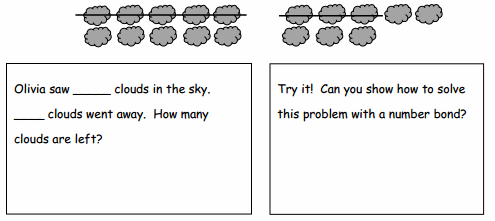
Answer:

Explanation:
Oliva saw 18 clouds in the sky. 8 clouds went away. In the above image we can observe a number sentence 18 – 8 = 10. Break eighteen into ten and eight. Take eight from the ten. It’s called the take from ten strategy. Cross out eight circles. Then two and eight make ten. Ten clouds are left.
A number bond is a simple addition of two numbers that add up to give the sum. In the above image we can observe a number sentence 18 – 8 = 10. Break eighteen into ten and eight. Subtract eight from the ten then we got two. ADD two with eight then we got ten. Ten clouds are left.